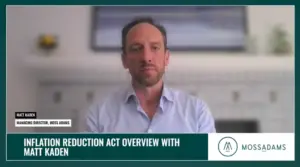Carbon Capture & Storage: The Race To Net Zero
The energy industry landscape is being rapidly altered and shifted by advances in carbon capture, utilization, and storage (CCUS) technology. As announcements and commitments to reduce carbon emission continue to come from industry and governments, E2B host Daniel Litwin speaks with Steve Hendrickson, President of Ralph E. Davis Associates, and Harrison Perrin, Petroleum Engineer with Ralph E. Davis Associates, to get more insight into why CCUS technologies are expected to have a significant impact in the energy industry in 2021 and beyond.
Sustainability-minded advancements like storing CO2 underground via CCUS technologies, often into saline aquifers located deep underground, are transforming the ways in which we view the byproducts of energy production and the industry’s overall impact on the environment.
In addition to keeping carbon emissions at lower levels, this stored CO2—sourced from high-emitting industrial production facilities such as ethanol production, cement manufacturing, and so forth—has other applications such as in enhanced oil recovery (EOR).
“One of the challenges of EOR is the proximity of the field to the CO2 source,” Hendrickson says.
CCUS technology development is being catalyzed by the federal government via tax credits. In January 2021, the IRS finalized its CCUS tax credit guidance, adopting several new regulations. Most notably, previously adopted 45Q tax credits were increased to $50 per metric ton of CO2 disposed in 2026. While CCUS isn’t new, CO2 emitters are evaluating now-economic CCUS projects without an EOR component.
“Storing carbon underground doesn’t make any money on its own,” Hendrickson says. “The only impetus to do it is either a carrot or a stick and right now we have a carrot in the form of these 45Q tax credits.”
However, challenges can and do surface in the development cycle and feasibility stage of a CCUS project(s) as regulatory red tape can hamstring progress.
“The EPA is more rigorous with their regulations around CCUS than the state agencies are for natural gas wells,” Perrin says. “For CO2 storage, even once you’re done injecting, you have to monitor them after closure for approximately 50 years unless you get special permission. So, it’s quite a bit different between the two in terms of the regulation.”
In addition, CCUS companies face some notable difficulties in capturing and storing carbon that aren’t present for their counterparts in natural gas storage—a useful analog for developing CCUS projects—and large-scale deployment will require solutions that ensure CCUS processes are cost-effective enough to be a viable option for years to come.
“The process of designing and constructing a natural gas storage project is very similar in many respects—especially from a down hole perspective—as a carbon sequestration project would be,” Hendrickson says. “So, the workflows around doing a carbon storage project are very analogous to the same workflows that we’ve used in natural gas storage projects.”
Follow us on social media for the latest updates in B2B!
Twitter – @MarketScale
Facebook – facebook.com/marketscale
LinkedIn – linkedin.com/company/marketscale






